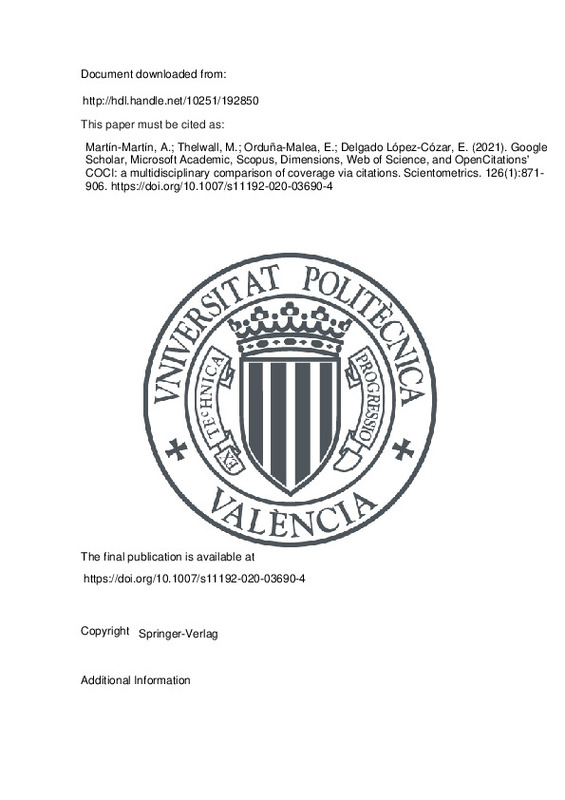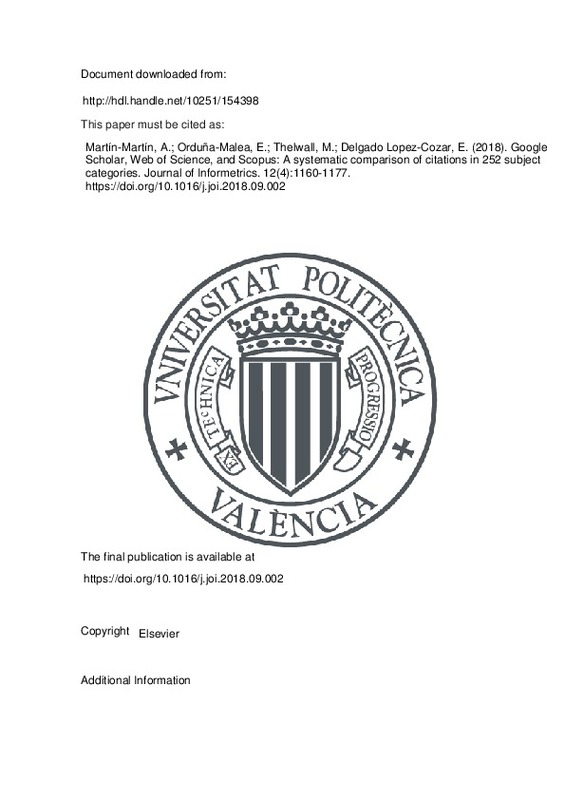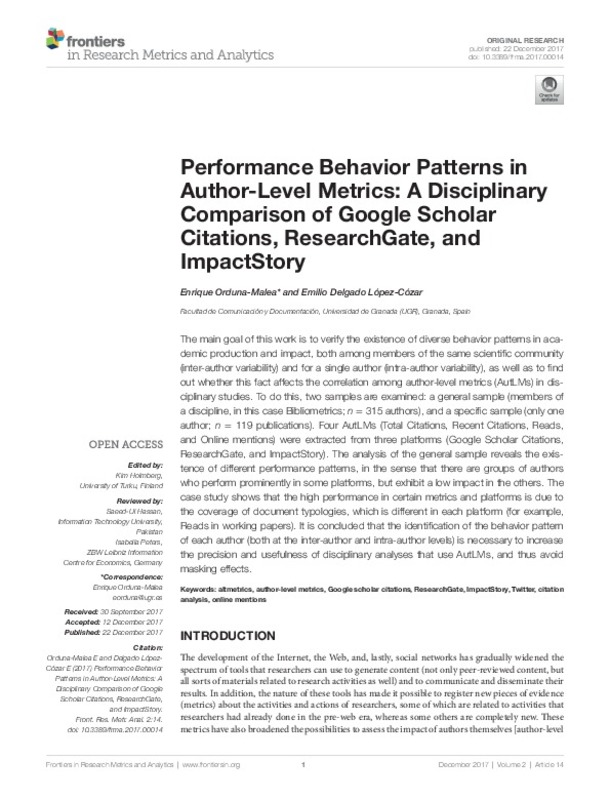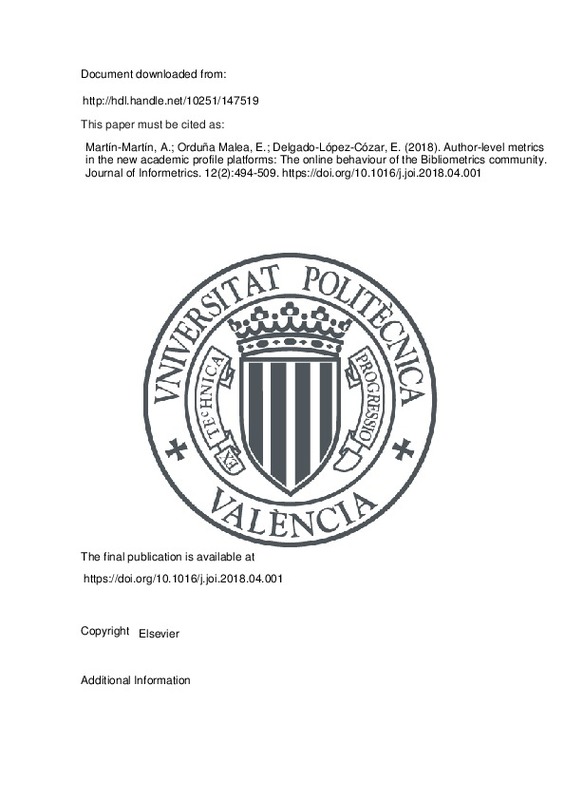Baas, J., Schotten, M., Plume, A., Côté, G., & Karimi, R. (2020). Scopus as a curated, high-quality bibliometric data source for academic research in quantitative science studies. Quantitative Science Studies, 1(1), 377–386. https://doi.org/10.1162/qss_a_00019.
Beel, J., & Gipp, B. (2009a). Google Scholar’s ranking algorithm: The impact of articles’ age (an empirical study). Sixth International Conference on Information Technology: New Generations, 2009, 160–164. https://doi.org/10.1109/ITNG.2009.317.
Beel, J., & Gipp, B. (2009b). Google Scholar’s ranking algorithm: The impact of citation counts (An empirical study). Third International Conference on Research Challenges in Information Science, 2009, 439–446. https://doi.org/10.1109/RCIS.2009.5089308.
[+]
Baas, J., Schotten, M., Plume, A., Côté, G., & Karimi, R. (2020). Scopus as a curated, high-quality bibliometric data source for academic research in quantitative science studies. Quantitative Science Studies, 1(1), 377–386. https://doi.org/10.1162/qss_a_00019.
Beel, J., & Gipp, B. (2009a). Google Scholar’s ranking algorithm: The impact of articles’ age (an empirical study). Sixth International Conference on Information Technology: New Generations, 2009, 160–164. https://doi.org/10.1109/ITNG.2009.317.
Beel, J., & Gipp, B. (2009b). Google Scholar’s ranking algorithm: The impact of citation counts (An empirical study). Third International Conference on Research Challenges in Information Science, 2009, 439–446. https://doi.org/10.1109/RCIS.2009.5089308.
Beel, J., & Gipp, B. (2009c). Google Scholar’s ranking algorithm: An introductory overview. In Proceedings of the 12th International Conference on Scientometrics and Informetrics (ISSI’09) (pp. 230–241). http://www.issi-society.org/proceedings/issi_2009/ISSI2009-proc-vol1_Aug2009_batch2-paper-1.pdf
Birkle, C., Pendlebury, D. A., Schnell, J., & Adams, J. (2020). Web of Science as a data source for research on scientific and scholarly activity. Quantitative Science Studies, 1(1), 363–376. https://doi.org/10.1162/qss_a_00018.
Chapman, K., & Ellinger, A. E. (2019). An evaluation of Web of Science, Scopus and Google Scholar citations in operations management. The International Journal of Logistics Management, 30(4), 1039–1053. https://doi.org/10.1108/IJLM-04-2019-0110.
Damerau, F. J. (1964). A technique for computer detection and correction of spelling errors. Communications of the ACM, 7(3), 171–176. https://doi.org/10.1145/363958.363994.
Delgado López-Cózar, E., & Martín-Martín, A. (2018). Apagón digital de la producción científica española en Google Scholar. Anuario ThinkEPI, 12, 265–276. https://doi.org/10.3145/thinkepi.2018.40.
Delgado López-Cózar, E., Orduna-Malea, E., & Martín-Martín, A. (2019). Google Scholar as a data source for research assessment. In W. Glaenzel, H. Moed, U. Schmoch, & M. Thelwall (Eds.), Springer handbook of science and technology indicators. Berlin: Springer.
Dowle, M., Srinivasan, A., Gorecki, J., Chirico, M., Stetsenko, P., Short, T., Lianoglou, S., Antonyan, E., Bonsch, M., & Parsonage, H. (2018). data.table: Extension of ‘data.frame’ (1.11.4).
Else, H. (2018, April 11). How I scraped data from Google Scholar. Nature. https://doi.org/10.1038/d41586-018-04190-5
Forveille, T. (2019). A&A ranking by Google. Astronomy & Astrophysics, 628, E1. https://doi.org/10.1051/0004-6361/201936429.
Fraser, N., Brierley, L., Dey, G., Polka, J. K., Pálfy, M., & Coates, J. A. (2020). Preprinting a pandemic: The role of preprints in the COVID-19 pandemic. BioRxiv, 2020.05.22.111294. https://doi.org/10.1101/2020.05.22.111294
Gusenbauer, M. (2018). Google Scholar to overshadow them all? Comparing the sizes of 12 academic search engines and bibliographic databases. Scientometrics. https://doi.org/10.1007/s11192-018-2958-5.
Gusenbauer, M., & Haddaway, N. R. (2020). Which academic search systems are suitable for systematic reviews or meta-analyses? Evaluating retrieval qualities of Google Scholar, PubMed, and 26 other resources. Research Synthesis Methods, 11(2), 181–217. https://doi.org/10.1002/jrsm.1378.
Haddaway, N., & Gusenbauer, M. (2020, February 3). A broken system: Why literature searching needs a FAIR revolution. Impact of Social Sciences. https://blogs.lse.ac.uk/impactofsocialsciences/2020/02/03/a-broken-system-why-literature-searching-needs-a-fair-revolution/.
Halevi, G., Moed, H., & Bar-Ilan, J. (2017). Suitability of Google Scholar as a source of scientific information and as a source of data for scientific evaluation—Review of the Literature. Journal of Informetrics, 11(3), 823–834. https://doi.org/10.1016/J.JOI.2017.06.005.
Harzing, A. W. (2016). Microsoft Academic (Search): A Phoenix arisen from the ashes? In Scientometrics (Vol. 108, No. 3, pp. 1637–1647). Springer, Netherlands. https://doi.org/10.1007/s11192-016-2026-y
Harzing, A.-W. (2016). Sacrifice a little accuracy for a lot more comprehensive coverage. Harzing.Com. https://harzing.com/blog/2016/08/sacrifice-a-little-accuracy-for-a-lot-more-comprehensive-coverage
Harzing, A. W. (2019). Two new kids on the block: How do Crossref and Dimensions compare with Google Scholar, Microsoft Academic, Scopus and the Web of Science? In Scientometrics (Vol. 120, Issue 1, pp. 341–349). Springer, Netherlands. https://doi.org/10.1007/s11192-019-03114-y
Harzing, A.-W., & Alakangas, S. (2016). Google Scholar, Scopus and the Web of Science: A longitudinal and cross-disciplinary comparison. Scientometrics, 106(2), 787–804. https://doi.org/10.1007/s11192-015-1798-9.
Harzing, A. W., & Alakangas, S. (2017a). Microsoft Academic: Is the phoenix getting wings? In Scientometrics (Vol. 110, Issue 1, pp. 371–383). Springer, Netherlands. https://doi.org/10.1007/s11192-016-2185-x
Harzing, A. W., & Alakangas, S. (2017b). Microsoft Academic is one year old: The Phoenix is ready to leave the nest. In Scientometrics (Vol. 112, Issue 3, pp. 1887–1894). Springer, Netherlands. https://doi.org/10.1007/s11192-017-2454-3
Haunschild, R., Hug, S. E., Brändle, M. P., & Bornmann, L. (2018). The number of linked references of publications in Microsoft Academic in comparison with the Web of Science. In Scientometrics (Vol. 114, Issue 1, pp. 367–370). Springer, Netherlands. https://doi.org/10.1007/s11192-017-2567-8
Heibi, I., Peroni, S., & Shotton, D. (2019). Software review: COCI, the OpenCitations Index of Crossref open DOI-to-DOI citations. Scientometrics. https://doi.org/10.1007/s11192-019-03217-6.
Hendricks, G., Tkaczyk, D., Lin, J., & Feeney, P. (2020). Crossref: The sustainable source of community-owned scholarly metadata. Quantitative Science Studies, 1(1), 414–427. https://doi.org/10.1162/qss_a_00022.
Herzog, C., Hook, D., & Konkiel, S. (2020). Dimensions: Bringing down barriers between scientometricians and data. Quantitative Science Studies, 1(1), 387–395. https://doi.org/10.1162/qss_a_00020.
Hook, D. W., Porter, S. J., & Herzog, C. (2018). Dimensions: Building Context for Search and Evaluation. Frontiers in Research Metrics and Analytics, 3, 23. https://doi.org/10.3389/frma.2018.00023.
Huang, C.-K., Neylon, C., Brookes-Kenworthy, C., Hosking, R., Montgomery, L., Wilson, K., et al. (2020). Comparison of bibliographic data sources: Implications for the robustness of university rankings. Quantitative Science Studies. https://doi.org/10.1162/qss_a_00031.
Hug, S. E., & Brändle, M. P. (2017). The coverage of Microsoft Academic: Analyzing the publication output of a university. Scientometrics, 113(3), 1551–1571. https://doi.org/10.1007/s11192-017-2535-3.
Kousha, K., & Thelwall, M. (2018). Can Microsoft Academic help to assess the citation impact of academic books? Journal of Informetrics, 12(3), 972–984. https://doi.org/10.1016/j.joi.2018.08.003.
Kousha, K., Thelwall, M., & Abdoli, M. (2018). Can Microsoft Academic assess the early citation impact of in-press articles? A multi-discipline exploratory analysis. Journal of Informetrics, 12(1), 287–298. https://doi.org/10.1016/j.joi.2018.01.009.
Krassowski, M. (2020). ComplexUpset. https://github.com/krassowski/complex-upset
Larsson, J., Godfrey, A. J. R., Kelley, T., Eberly, D. H., Gustafsson, P., & Huber, E. (2018). eulerr: Area-Proportional Euler and Venn Diagrams with Circles or Ellipses (4.1.0).
Levenshtein, V. I. (1966). Binary codes capable of correcting deletions, insertions, and reversals. Soviet Physics Doklady, 10(8), 707–710.
Martín-Martín, A. (2018). Code to extract bibliographic data from Google Scholar (v1.0). Zenodo. https://doi.org/10.5281/zenodo.1481076
Martín-Martín, A., & Delgado López-Cózar, E. (2016). Reading Web of Science data into R (0.6).
Martin-Martin, A., Orduna-Malea, E., Harzing, A.-W., & Delgado López-Cózar, E. (2017). Can we use Google Scholar to identify highly-cited documents? Journal of Informetrics, 11(1), 152–163. https://doi.org/10.1016/j.joi.2016.11.008.
Martín-Martín, A., Orduna-Malea, E., Thelwall, M., & Delgado López-Cózar, E. (2018). Google Scholar, Web of Science, and Scopus: A systematic comparison of citations in 252 subject categories. Journal of Informetrics, 12(4), 1160–1177. https://doi.org/10.1016/J.JOI.2018.09.002.
Moed, H. F., Bar-Ilan, J., & Halevi, G. (2016). A new methodology for comparing Google Scholar and Scopus. Journal of Informetrics, 10(2), 533–551. https://doi.org/10.1016/j.joi.2016.04.017.
Orduña-Malea, E., & Delgado-López-Cózar, E. (2018). Dimensions: Re-discovering the ecosystem of scientific information. Profesional de La Informacion, 27(2), 420–431. https://doi.org/10.3145/epi.2018.mar.21.
Orduña-Malea, E., Martín-Martín, A., Ayllon, M., & Delgado López-Cózar, E. (2014). The silent fading of an academic search engine: The case of Microsoft Academic Search. Online Information Review, 38(7), 936–953. https://doi.org/10.1108/OIR-07-2014-0169.
Orduña-Malea, E., Martín-Martín, A., Ayllón, J. M., & Delgado López-Cózar, E. (2016). La revolución Google Scholar: Destapando la caja de Pandora académica. Universidad de Granada y Unión de Editoriales Universitarias Españolas.
Orduna-Malea, E., Martín-Martín, A., & Delgado López-Cózar, E. (2017). Google Scholar as a source for scholarly evaluation: A bibliographic review of database errors. Revista Española de Documentación Científica, 40(4), e185. https://doi.org/10.3989/redc.2017.4.1500.
Orduna-Malea, E., Martín-Martín, A., & Delgado López-Cózar, E. (2018). Classic papers: Using Google Scholar to detect the highly-cited documents. In 23rd International conference on science and technology indicators (pp. 1298–1307). https://doi.org/10.31235/osf.io/zkh7p
Ortega, J. L. (2014). Academic search engines: A quantitative outlook. Cambridge: Chandos Publishing.
Peroni, S., & Shotton, D. (2020). OpenCitations, an infrastructure organization for open scholarship. Quantitative Science Studies, 1(1), 428–444. https://doi.org/10.1162/qss_a_00023.
R Core Team. (2014). R: A Language and Environment for Statistical Computing.
Rovira, C., Codina, L., Guerrero-Solé, F., & Lopezosa, C. (2019). Ranking by relevance and citation counts, a comparative study: Google Scholar, Microsoft academic, WoS and scopus. Future Internet, 11(9), 202. https://doi.org/10.3390/fi11090202.
Shotton, D. (2013). Publishing: Open citations. Nature, 502(7471), 295–297. https://doi.org/10.1038/502295a.
Shotton, D. (2018). Funders should mandate open citations. Nature, 553(7687), 129. https://doi.org/10.1038/d41586-018-00104-7.
Tay, A. (2019, April 3). 6 reasons why you should try Lens.org. Medium. https://medium.com/@aarontay/6-reasons-why-you-should-try-lens-org-c40abb09ec6f
Thelwall, M. (2017). Microsoft Academic: A multidisciplinary comparison of citation counts with Scopus and Mendeley for 29 journals. Journal of Informetrics, 11(4), 1201–1212. https://doi.org/10.1016/j.joi.2017.10.006.
Thelwall, M. (2018a). Does Microsoft Academic find early citations? Scientometrics, 114(1), 325–334. https://doi.org/10.1007/s11192-017-2558-9.
Thelwall, M. (2018b). Microsoft Academic automatic document searches: Accuracy for journal articles and suitability for citation analysis. Journal of Informetrics, 12(1), 1–9. https://doi.org/10.1016/j.joi.2017.11.001.
Thelwall, M. (2018c). Dimensions: A competitor to Scopus and the Web of Science? Journal of Informetrics, 12(2), 430–435. https://doi.org/10.1016/j.joi.2018.03.006.
van der Loo, M., van der Laan, J., R Core Team, Logan, N., & Muir, C. (2018). stringdist: Approximate String Matching and String Distance Functions (0.9.5.1).
van Eck, N. J., & Waltman, L. (2019). Accuracy of citation data in Web of Science and Scopus.
van Eck, N. J., Waltman, L., Larivière, V., & Sugimoto, C. (2018). Crossref as a new source of citation data: A comparison with Web of Science and Scopus. https://www.cwts.nl/blog?article=n-r2s234&title=crossref-as-a-new-source-of-citation-data-a-comparison-with-web-of-science-and-scopus
Van Noorden, R. (2014). November 7). Google Scholar pioneer on search engine’s future. Nature.. https://doi.org/10.1038/nature.2014.16269.
Visser, M., van Eck, N. J., & Waltman, L. (2020). Large-scale comparison of bibliographic data sources: Scopus, Web of Science, Dimensions, Crossref, and Microsoft Academic. https://arxiv.org/abs/2005.10732
Walker, A., & Braglia, L. (2018). openxlsx: Read, Write and Edit XLSX Files (4.1.0).
Wang, K., Shen, Z., Huang, C., Wu, C.-H., Dong, Y., & Kanakia, A. (2020). Microsoft academic graph: When experts are not enough. Quantitative Science Studies, 1(1), 396–413. https://doi.org/10.1162/qss_a_00021.
Wickham, H. (2016). ggplot2: Elegant graphics for data analysis. New York: Springer.
Wilke, C. O. (2019). cowplot: Streamlined Plot Theme and Plot Annotations for ‘ggplot2′.
Wu, J., Kim, K., & Giles, C. L. (2019). CiteSeerX: 20 years of service to scholarly big data. Proceedings of the Conference on Artificial Intelligence for Data Discovery and Reuse. https://doi.org/10.1145/3359115.3359119.
[-]







![[Cerrado]](/themes/UPV/images/candado.png)





